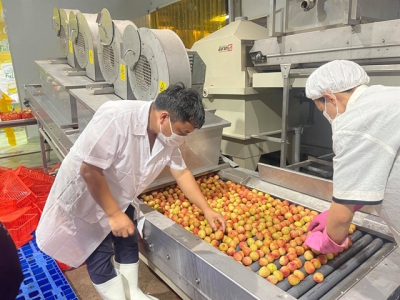20,000 tonnes of lychee exported to Japan

BẮC GIANG — A ceremony took place in the northern province of Bắc Giang’s Tân Yên District on Wednesday to mark the export of 20,000 tonnes of thiều lychees to Japan.
Lychee processing at Global Export and Import Foodstuff JSC in the northern province of Bắc Giang. — VNS Photo
According to the province’s Department of Agriculture and Rural Development, the shipments were made by Global Export and Import Foodstuff JSC and Chánh Thu Fruit Import-Export Co Ltd.
This is the second year Bắc Giang thiều lychees have entered the Japanese market, but this year's achievement is extra special because of the current COVID-19 outbreak in the area.
Chairman of the Bắc Giang Provincial People’s Committee Lê Anh Dương said local authorities have taken measures to ensure the quality, food safety and hygiene of the fruit.
Speaking at the ceremony, Phan Thế Tuấn, vice chairman of the provincial People’s Committee said in the context of complicated changes caused by the COVID-19 pandemic, Bắc Giang Province has built strong lychee growing areas, especially in Tân Yên and Lục Ngạn districts.
The province has prepared special conditions, ensuring absolute safety in terms of health, security and order for businesses, traders, and drivers entering Bắc Giang to purchase and consume lychee. The first shipment of lychees exported to Japan, a large market with very high quality standards, has shown the locality’s determination, seriousness and responsibility in the process of producing and consuming lychee, he added.
The authorities also actively worked with the Japanese Embassy in Việt Nam to receive a Geographical Indication (GI) certificate for the lychees grown in Lục Ngạn District, making it the first Vietnamese product to obtain such certification from Japan.
Since the pandemic has seen complicated developments, particularly as Bắc Giang is now one of the country’s hotspots, the provincial authorities have well prepared for lychees consumption this year.
Nguyễn Viết Toàn, Chairman of Tân Yên District People's Committee, said: “In 2021, in the context of the COVID-19, the district will focus on ensuring lychee areas that are clean and not affected by the pandemic such as taking all F1 subjects out of the district's lychee area, setting up checkpoints to control people and vehicles entering the concentrated lychee area, ensuring regulations on COVID-19 prevention.”
This year, Bắc Giang Province has around 28,100 ha of lychees with an estimated output of more than 180,000 tonnes, an increase of 15,000 tonnes year-on-year. This includes 45,000 tonnes of early-ripening lychee harvested on an estimated area of 6,050 ha along with 135,000 tonnes of lychee from the main crop on an area of 22,050 ha.
“The Tân Yên early-ripening lychee has the best quality so far, ensuring food hygiene and safety and not affected by COVID-19,” he added.
Ngô Tường Vy, deputy director of Chánh Thu Fruit Import-Export Co Ltd said the lychee exports this year would face difficulties due to COVID-19. However, the GI certificate from Japan would help customers more believe in the lychee’s quality.
The province will also take part in a teleconference on June 8 to promote the domestic consumption and export of lychee. The video conference will be held in 29 venues, connecting representatives from Việt Nam, China, Japan, Singapore, and Australia.
There have been five enterprises that have signed the contract to export lychee to the Japanese market including Global Export and Import Foodstuff JSC, Chánh Thu Fruit Import-Export Co Ltd, Ameii Vietnam JSC, Bamboo International JSC and Red Dragon Company.
Có thể bạn quan tâm
 Building and protecting trademarks of agricultural products: Register for trademark protect
Building and protecting trademarks of agricultural products: Register for trademark protect Vietnamese agricultural products have now been exported to nearly 200 countries and territories, with many items earning billions of dollars each year.
 Slashed Philippine rice tariffs an opportunity for Vietnamese exporters
Slashed Philippine rice tariffs an opportunity for Vietnamese exporters The Philippines’s move to lower tariffs on imported rice will open opportunities for Việt Nam to maintain stable supply of the product for the country
 Northern province seeks ways to sell lychees as Covid hits exports
Northern province seeks ways to sell lychees as Covid hits exports Bac Giang, Vietnam's lychee growing hub, is switching from export of the fruit to selling in the domestic market sue to the Covid-19 pandemic, and farmers